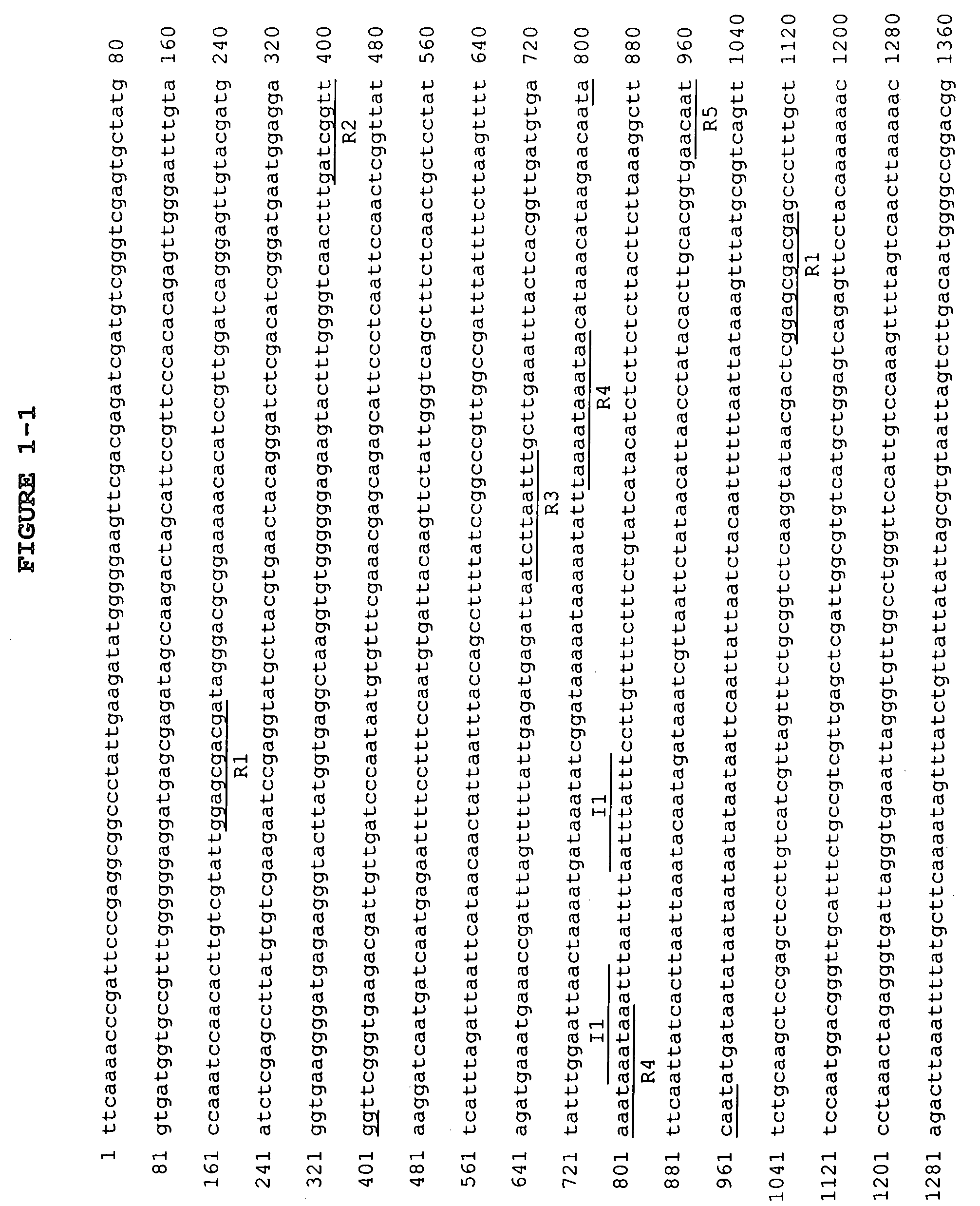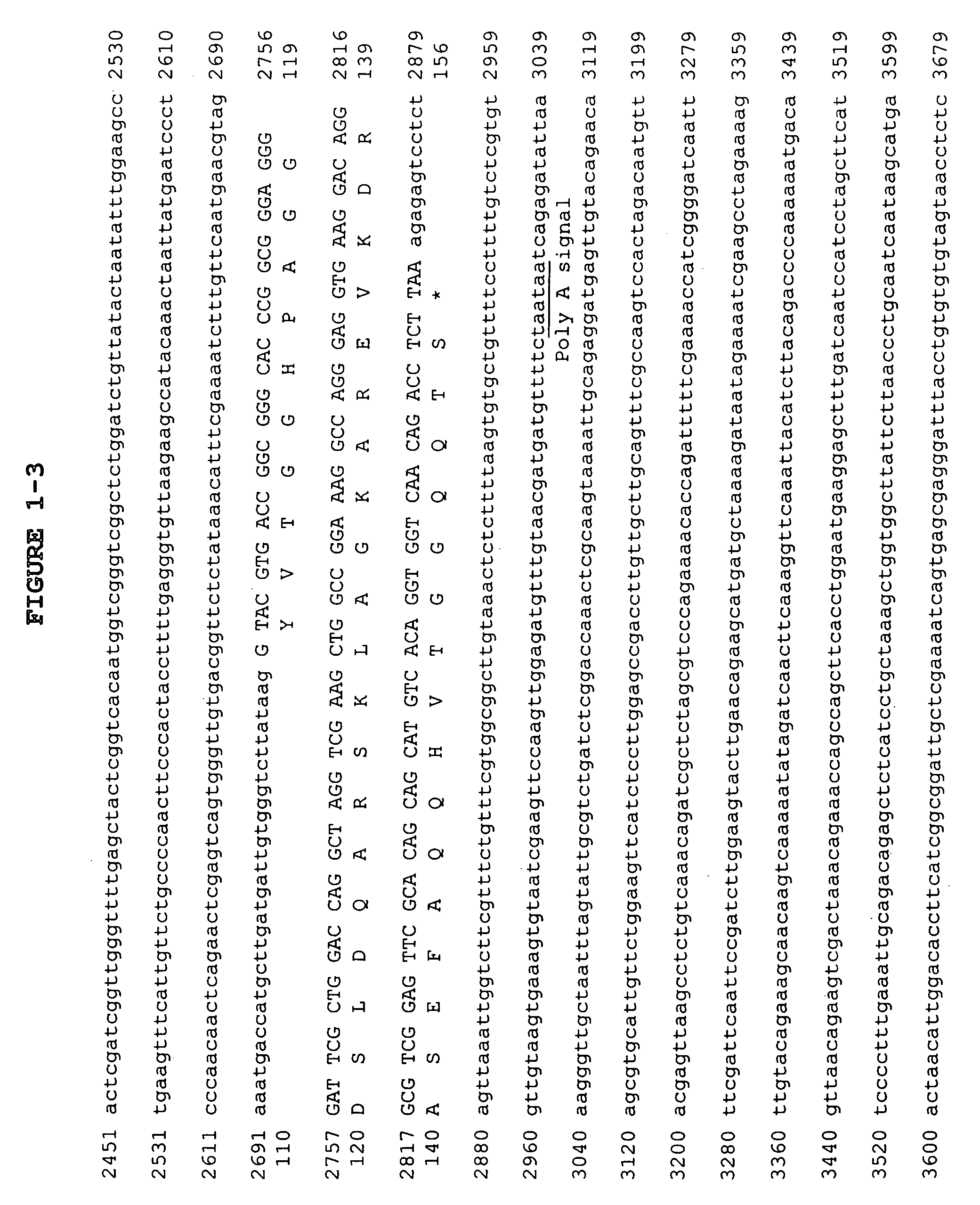Flax seed specific promoters
a promoter and flax seed technology, applied in the field of plant genetic engineering methods, can solve the problems of large investment required for the agronomic plant line of elites, limited methods taught by wo 98/18948, and limited expression levels
- Summary
- Abstract
- Description
- Claims
- Application Information
AI Technical Summary
Benefits of technology
Problems solved by technology
Method used
Image
Examples
example 1
Isolation of Seed-Specific Flax Promoters
[0142]Seed specific cDNA clones were isolated form a flax seed specific cDNA-library. These cDNA clones were sequenced and the Basic Local Alignment Search Tool (BLAST) was used to compare these sequences against others in public databases such as Genbank. This comparison revealed that the deduced amino acid sequence of several of the isolated cDNAs had a high degree of similarity to both the low and high molecular weight dass of oleosins, 2S-albumin and legumin-like storage proteins. Probes were prepared individually from (portions of) cDNAs encoding oleosins, 2S albumin and legumin-like storage proteins and these were used to screen a genomic library prepared from the flax line Forge that is homozygous for four rust resistance genes (Anderson et al. (1997), The Plant Cell 9: 641-651). Several positive lambda clones for each probe were identified after high-stringency screening. The inserts were subcloned into the plasmid vector pBluescript ...
example 2
Seed Specific Expression of Flax Oleosin Genes
[0148]FIG. 6 shows a Northern blot analysis of the seed specific expression of flax oleosins. Northern hybridization of the two oleosin mRNA in different tissues. Ten μg of total RNA was extracted from different tissues, R, root; C, cotyledon; L, leaf; S, seed capsule; E, embryo. The membrane was probed with (A) cDNA encoding high molecular weight (H)-isoform (identical to coding sequence as presented in FIG. 2) and (B) cDNA encoding low molecular weight (L)-isoform (identical to coding sequence as presented in FIG. 1). Both the transcripts are expressed only in the embryo and seed capsule, which contains embryos.
example 3
Developmental Expression of Flax Oleosin Genes During Seed Development
[0149]FIG. 7 shows a Northern blot analysis of the developmental expression of flax oleosins during seed development. 15 μg per lane of total RNA was loaded in each lane on agarose / formaldehyde gel and blotted onto HybondN+ membrane. 10J: This membrane was probed using the 32P dCTP labeled flax oleosin cDNA clone (low molecular weight isoform). Stages indicated are the number of days past anthesis (DPA). 3T) 15 μg per lane of total RNA was loaded in each lane on agarose / formaldehyde gel and blotted onto HybondN+ membrane. 3T: This membrane was probed using the 32P dCTP labeled flax oleosin cDNA clone (high molecular weight isoform). Both the transcripts were expressed very early in development (6DPA, early cotyledonary stage). Expression is maximum at 16 to 20 DPA (late cotyledonary stage) and declines at 22 DPA (mature embryos).
PUM
| Property | Measurement | Unit |
|---|---|---|
| Composition | aaaaa | aaaaa |
| Nucleic acid sequence | aaaaa | aaaaa |
Abstract
Description
Claims
Application Information
 Login to View More
Login to View More - R&D
- Intellectual Property
- Life Sciences
- Materials
- Tech Scout
- Unparalleled Data Quality
- Higher Quality Content
- 60% Fewer Hallucinations
Browse by: Latest US Patents, China's latest patents, Technical Efficacy Thesaurus, Application Domain, Technology Topic, Popular Technical Reports.
© 2025 PatSnap. All rights reserved.Legal|Privacy policy|Modern Slavery Act Transparency Statement|Sitemap|About US| Contact US: help@patsnap.com



